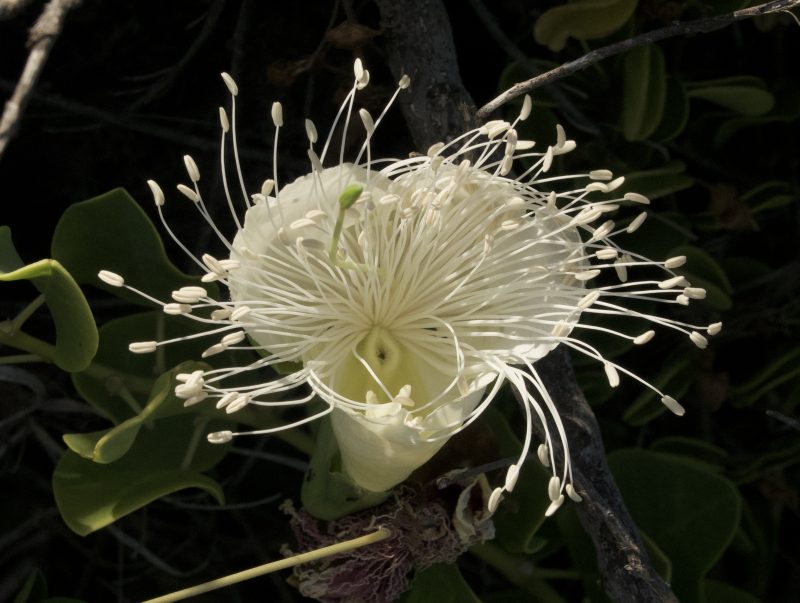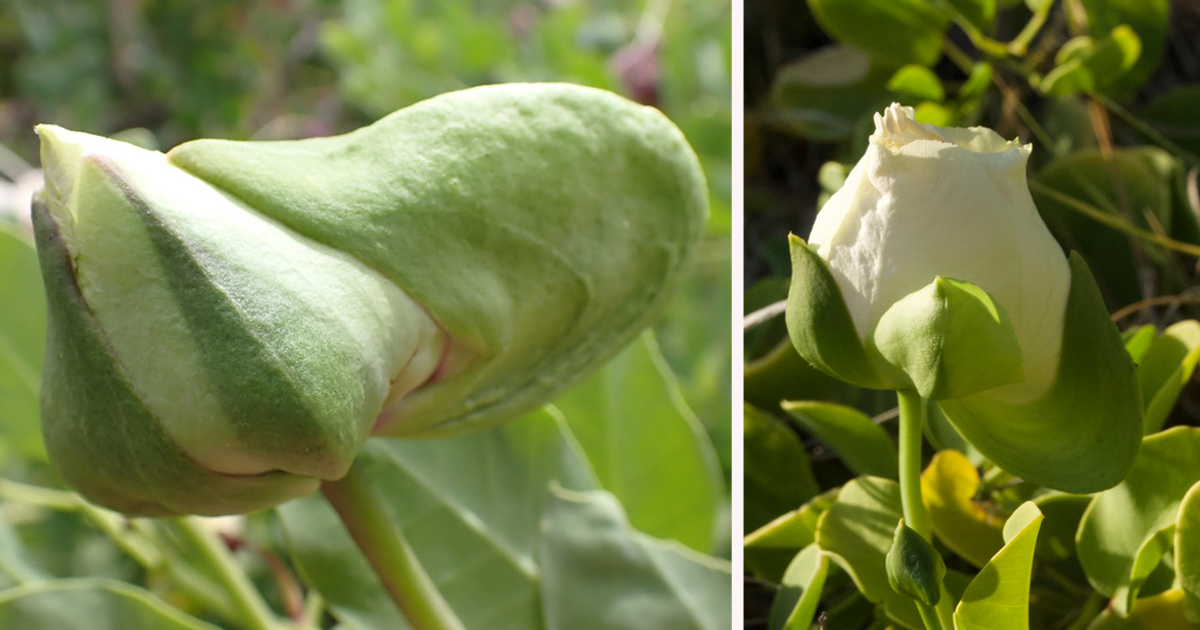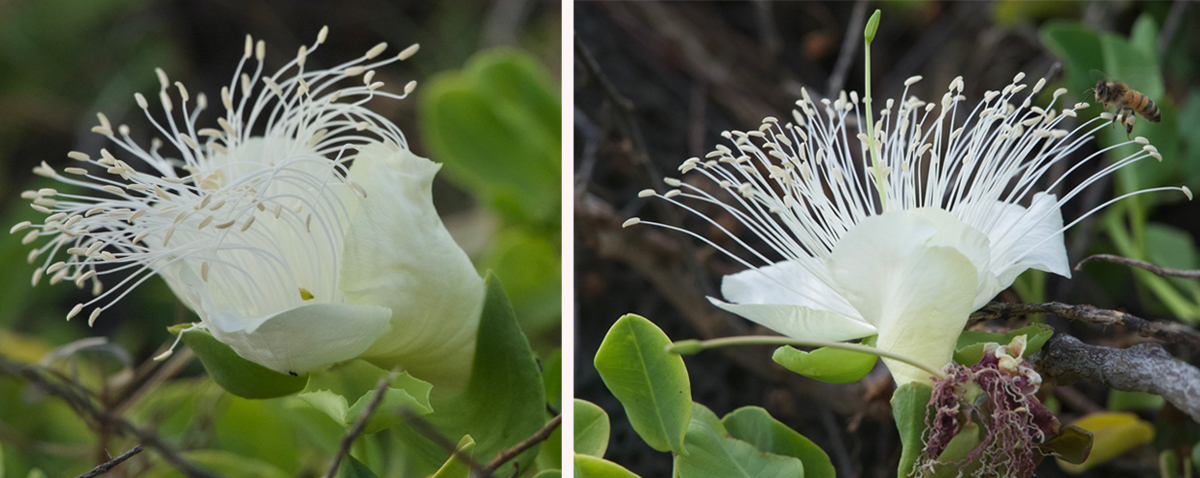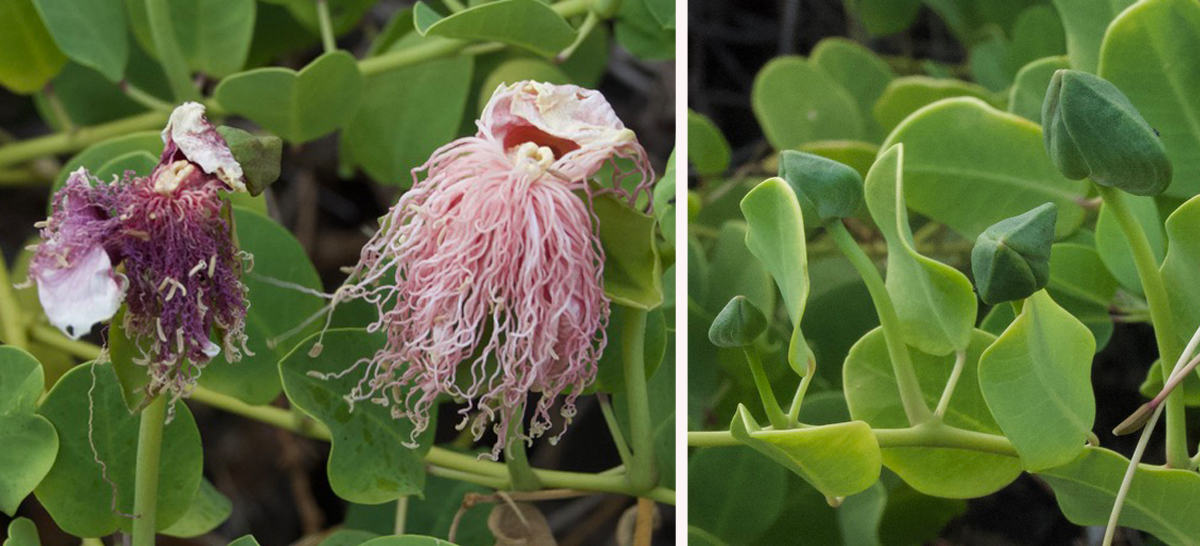Ulu Kanu: Capparis sandwichiana

Why Maiapilo?
Because it’s my favorite. Yes, you can find it blooming this time of year (depending on where you are, you might expect to see more blossoms from late spring to summer). And, yes, the first of four full supermoons in 2023 happens this month (on the 3rd), so it’s the perfect time to start a moon garden. But, really, it’s just because it’s my favorite. As the folks at Hui Ku Maoli Ola wrote, “Simply put, if you have a white rose and take out all the center petals and replace them with a white ‘ohi‘a lehua flower, you’ll have a maiapilo flower”. White rose: the best rose. White ‘ohi‘a lehua: the stuff of legend. So put the two together and you have floral perfection.
More About Maiapilo
One of the reasons I love this plant so much is because it’s a night bloomer. It is best enjoyed during those times when the sun is going down, the moon is up, or the morning just touches the sky. It’s especially appreciated by native moths (like the rare, endemic Manduca blackburni) who pollinate the flowers while taking their nectar. The moths are likely attracted by the gentle swaying of the plant in the breeze, the amazing fragrance, or the bright white reflection of the flowers in the moonlight. Ultraviolet-induced visible fluorescence (UVIVF) photographer, Craig Burrows, took some magical photos of maiapilo (you can see them here) in all their eventide glory. Oh, to be a moth and see this plant at night!
As mentioned earlier, another reason I love this plant is because of its scent. The name maiapilo is a mash up of the words “mai‘a” and “pilo”. Mai‘a means banana. Pilo is defined as “swampy, foul odor; halitosis; polluted”. Ahhh! Can you just smell it now?! No, but this name refers to the small, oblong fruit. It is green when immature and turns yellowish/orange when it is ripe. Unlike an ‘ono banana, however, the flesh is not always so appealing to the senses and smells kind of like some old mushrooms found at the bottom of a vegetable drawer. The flowers, however,…*chef’s kiss* Maiapilo is a coastal plant that thrives in summer, so chances are you’ll be smelling it on a warm day while walking along a rocky, sandy shoreline. One whiff of the flower and it’s like you’ve sipped from a glass of lemonade. Simply delightful.

 Number three reason why I am a fan is because of the way this flower blooms. If you happen upon a plant near dusk or early morning and you see a little white bud peeking out of some green, do yourself a favor and just sit and watch it. Grab a snack, put your phone on a tripod, and be amazed. The green sepals will open up like a little treasure box, the white bud will emerge and then begin to unfurl, and then there are just these big, gorgeous petals and sprawling stamens in front of you. You can watch it happen here.
Number three reason why I am a fan is because of the way this flower blooms. If you happen upon a plant near dusk or early morning and you see a little white bud peeking out of some green, do yourself a favor and just sit and watch it. Grab a snack, put your phone on a tripod, and be amazed. The green sepals will open up like a little treasure box, the white bud will emerge and then begin to unfurl, and then there are just these big, gorgeous petals and sprawling stamens in front of you. You can watch it happen here.
I also think it’s cute the way they wilt throughout the day. After a while, they start to look like a bunch of squids that had a bad day. And the last reason I love this plant is because it’s useful. Maiapilo is part of the caper family (Capparaceae), and its relative, Capparis spinosa, is the one whose buds are harvested and eaten worldwide. In Hawai‘i, it is thought that the pounded plant was used to treat broken bones through application to the joints. Since I am at the point in life where hiking often means needing lots of lomi, yoga, and ibuprofen, having another option for healing doesn’t hurt.
How To Grow It
Fresh maiapilo seeds can germinate quickly. The seeds can be put into thin, clear plastic containers filled with vermiculite and kept under a florescent light. Sow them shallow and spray them with water about once a week to keep the medium moist. After a germinating seed has shed its seedcoat and developed its seedleaves, it can be transferred to a dibble tube or other container for storage in a semi-shaded area where it can be watered lightly and daily. Too much water and they can be more susceptible to damping-off fungi. When the main stem of the plant is about a fourth of an inch in diameter, it can be planted in the garden or repotted. Full sun and well-drained soil is best. Let the ground dry out in between waterings, and watch out for cabbage moth caterpillars or leafcutter bees. If the stems start to wither and yellow, quickly prune and discard the dead stem. Once established, it requires very little water, so it is an excellent choice for a xeriscape garden.
Sources
https://hawaiiannativeplants.com/ourplants/maiapilo/
https://www.nativehawaiiangarden.org/flowering-plants/maiapilo
Wagner, Warren L., Herbst, Derral R. and Sohmer, S.H.. Manual of the Flowering Plants of Hawai’i, University of Hawaii Press, 1990.
https://wehewehe.org/



